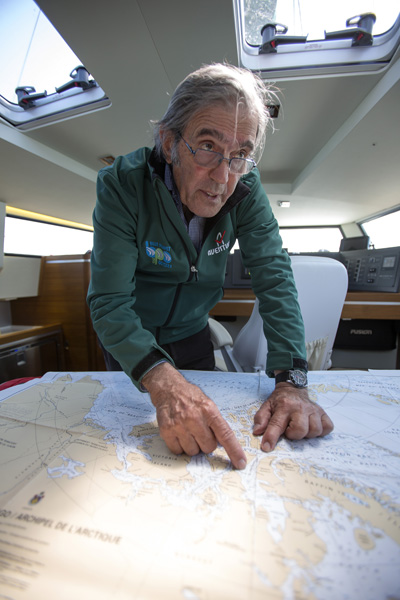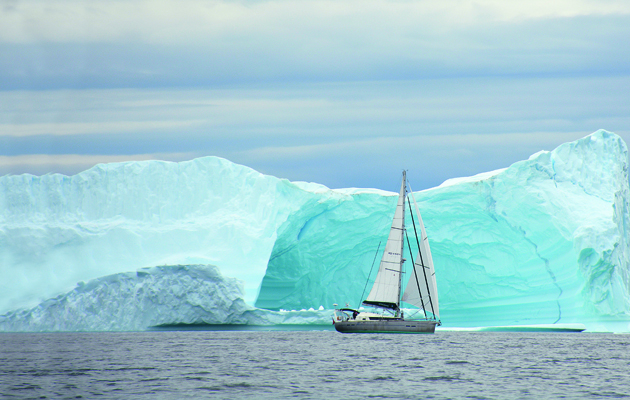ARC founder and well-known cruising author Jimmy Cornell had a boat built specially for the North West Passage, but it took two attempts and some terrifying encounters with ice to do it
In the history of maritime exploration no other part of the world has proved to be more difficult and has taken longer to conquer. The reason is quite simple: in spite of all the advances in boat design, technology and methods of navigation, the challenges faced by those sailing in the high Arctic have remained basically the same.
Climate change, the effects of which are more obvious in the Arctic than anywhere else in the world, has certainly played a role in making conditions for a successful transit somewhat easier but, as I found out myself on my first attempt, however well prepared you might be, Mother Nature still has the last word.

Compared with other high-latitude destinations where I have sailed in the past, the challenge posed by the North West Passage is entirely different. Whereas elsewhere the success of a voyage depends primarily on the experience of the skipper and crew, as well as the suitability of the vessel, in the North West Passage there is one major factor that is entirely out of your control: ice.
Centuries of failed expeditions have resulted in a well-defined strategy for a transit, but sailors are still entirely at the mercy of ice conditions. During the short summer season, the sea ice, which has formed over the long winter, as well as the old ice left from previous winters, melts to a greater or lesser extent.
East to west passage
The ice normally retreats from west to east (Pacific to Atlantic), which means that in most years the eastern section of the North West Passage is the last to become ice-free. If planning an east to west passage, as I did in 2014, the way to deal with this is to arrive in July and wait until the ice has retreated to such an extent that a transit may be safely attempted.

Beating out of Pond Inlet
In recent years, the main hurdle has been Peel Sound, the symbolic exit for boats coming from the west, and the gateway to the Passage for those from the east. This potential choke-point has been entirely blocked by ice during the last two summers, although some boats have managed to bypass it by using the shortcut of Bellot Strait.
Unfortunately, in 2014 Aventura was not among them, as I decided to abandon my attempt. The lateness of the season meant that, even if we could get through, we would have to overwinter somewhere in Arctic Canada or Alaska. The prospect of ten months of virtual imprisonment was something I was not prepared to accept. (See our feature on Jimmy Cornell’s boat Aventura, designed specially for this voyage.)
The disappointment of having failed to reach the Pacific by this historic route was more than made up for by the rich experience of the two months we spent in the high Arctic. We were fortunate to see more wildlife than we had expected, from polar bears to walrus, musk oxen to sperm whales. The weather was also generally favourable, although we did have a few exciting moments. While waiting with other boats anchored in Dundas Harbour off Lancaster Sound for the ice situation to improve, we were caught by a storm with gusts of over 60 knots.
First attempt abandoned
The decision to turn around was painfully disappointing; we were well prepared and we’d had Aventura conceived and built for this very expedition. But what I learned from the example of Roald Amundsen and many other Arctic explorers is that challenges are there to be overcome, and that the success of any expedition depends not only on good preparation, but also on perseverance.

So in 2015 I decided to have another try, this time from the west. Having sailed Aventura through the Panama Canal to the North Pacific, by early July we had arrived at Dutch Harbor, a busy fishing port in the Aleutian Islands and a good place to prepare for a transit of the Passage.
On a cold and misty day Aventura passed through the Bering Strait that separates America from Asia, Alaska from Siberia. That dreaded name evocative of frozen wastes and murderous labour camps flooded me with distant memories of myself as a child growing up under a Communist regime, with no prospect of escape.
Yet here I was, sailing on my own boat through what I once considered to be the very end of the world. This is, above all, what I love about sailing; the absolute freedom it gives me to go to places that I would have never dreamt of ever going.
Soon we crossed another milestone, the Arctic Circle at 66°33’27”N, regarded by some as the symbolic gateway to the North West Passage. We were now in the Chukchi Sea, which is part of the Arctic Ocean, and as the latest ice chart showed the area south of Point Barrow to be clear, we continued sailing on blissfully unaware of what lay ahead of us.
As I came on watch at midnight and started filling the log, I noticed the air temperature had suddenly plummeted to 0°C and the sea to 4°C. Ice! I rushed into the cockpit and through the swirling mist I could make out the menacing shapes of large grey blocks of ice barely a few boat lengths away. I called the crew, we dropped the sails and started looking for a way out. We tried to steer a course towards the coast hoping that this was just an isolated patch of ice that could be easily bypassed. It was to no avail, as, on the contrary, the ice concentration was getting higher.
Trapped in ice
The situation behind us looked just as bad. Within minutes we were trapped and I estimated the concentration to be 8/10. Ice concentration is expressed in tenths: 1/10 is scattered ice, and a small boat can normally negotiate concentrations of 3/10 or even 4/10. Higher values are not easily dealt with, although a metal boat does have an advantage, as it is less at risk when having to force its way through the pack to reach an open lead. (See our feature on Cruising in Ice here.)

My main concern was that the ice around us appeared to be old ice, as the floes were larger and thicker than those I had come across in the eastern Arctic. I could only presume that it had broken off the polar ice pack and had been pushed our way by the north-easterly winds. Floes of new ice are relatively thin and usually easier to push out of the way with our 4m long ice poles, but the ice surrounding us was solid, dense old ice, hard as concrete.
It soon became clear that it would only yield to a more ruthless treatment of finding a gap between two floes, and brutally ramming Aventura through. It was an adrenalin-spiked exercise that usually worked and we managed to make some modest progress, only to be caught again. On a few occasions we reached a dead-end and had to backtrack.
Turning in a tight space proved even more difficult, but with the help of the bow thruster and careful manoeuvring we got out of some really tight corners, although I shuddered to think what those repeated collisions with solid ice might be doing to our hull.
Most worrying were the underwater ledges that extended out from some of the largest floes and could not easily be seen or avoided. I knew that if one of those hit one of the rudders – or worse still, the propeller – we would be in serious trouble. As I attempted to make a hard turn in one narrow space, we hit such a submerged ledge sideways, the violent shock knocking me off my feet.




